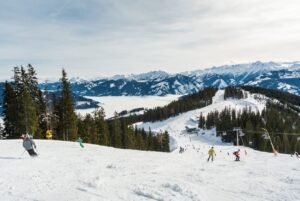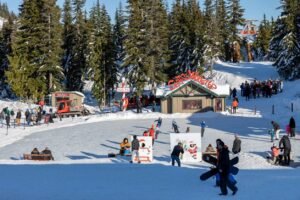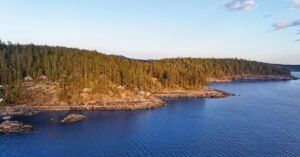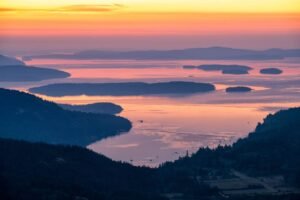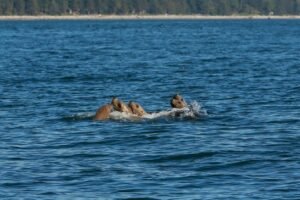Whistler is best known as one of the world’s premier ski destinations, a name that evokes deep powder, Olympic runs, and winter village charm. But when the snow melts, a different side of Whistler comes into focus.
Summer in Whistler is not a quieter season; it’s a broader one. The mountain trails open to hikers and bikers, five alpine lakes become warm-weather retreats, and the vibrant village hosts outdoor concerts, food festivals, and local markets nearly every weekend. It’s an ideal base for exploring British Columbia’s wild beauty, with the comforts of a modern resort and the depth of a cultural destination.
Whether you’re arriving from Vancouver, driving up from the U.S., or flying in from abroad, Whistler in summer offers more than you expect: alpine adventure, lake life, Indigenous heritage, local art, and the space to reconnect with nature—or simply relax.
Welcome to the West Coast Alps
Whistler is located about two hours north of Vancouver along the Sea-to-Sky Highway (Highway 99), a route widely regarded as one of the most scenic drives in North America. With dramatic coastal cliffs, waterfalls, and panoramic mountain views, the journey itself is part of the experience.
Travelers can reach Whistler by rental car, private shuttle, or bus from Vancouver International Airport (YVR). Once in Whistler, a car isn’t necessary—the village is walkable, and most lakes, trails, and parks are connected by bike paths or public transit.
Where to Stay
- Whistler Village: The central hub, ideal for travelers who want to be close to shops, dining, and lift access.
- Upper Village: Slightly quieter, with direct access to Blackcomb Mountain and nearby hiking trails.
- Creekside: A more relaxed area with its own amenities, great for longer stays or returning visitors.
- Lakeside neighborhoods: Options near Alta Lake or Green Lake provide easy access to summer recreation and a quieter atmosphere.
Summer Activities That Define Whistler
1. Explore the Alpine on Foot
When the snow clears, Whistler’s alpine terrain opens to hikers. Gondola access brings visitors above the treeline, where panoramic views, wildflower meadows, and glacier-fed lakes define the landscape.
- Shorter hikes near the gondolas are ideal for beginners or families.
- More experienced hikers can venture into Garibaldi Provincial Park, where options like Panorama Ridge, Garibaldi Lake, and Wedgemount Lake provide all-day challenges with unforgettable rewards.
Local Tip: Weather in the alpine can be unpredictable, even in summer. Bring layers, sunscreen, and plenty of water.
2. Bike the Trails: From Leisurely to Legendary
Whistler is a global destination for mountain biking, with a dedicated downhill bike park and an extensive network of cross-country trails for all skill levels.
But you don’t need to be an expert to enjoy cycling here. The Valley Trail, a 46-kilometre path system, links every neighborhood, park, and lake in Whistler. It’s ideal for cruising between breakfast, beach, and dinner. Bike rentals are easy to find, including e-bikes for those who want a bit of a boost.
3. Swim, Paddle, or Relax by the Lake
With five accessible lakes, summer in Whistler is as much about the water as it is about the mountains.
- Lost Lake: Quiet, forested, and close to the village—great for swimming or a shaded afternoon picnic.
- Alta Lake: Whistler’s largest lake, ideal for paddleboarding or canoeing.
- Green Lake: A glacial lake with vivid turquoise water. Cold and striking, great for photos and nature watching (but less ideal for swimming).
Most lakes have parks with docks, picnic areas, and bike access. Paddle gear is available to rent seasonally, mostly around Alta Lake.
4. Ride the PEAK 2 PEAK Gondola
One of Whistler’s most iconic summer attractions is the PEAK 2 PEAK Gondola, which connects the summits of Whistler and Blackcomb Mountains. It holds records for both height and length and offers incredible views of glaciers, forests, and distant peaks.
Once on top, short trails branch out from the gondola stations. Interpretive signage shares insight into geology, climate, and wildlife. It’s accessible for all ages, and you can spend anywhere from 1 to 4 hours exploring the mountaintop.
5. Connect with Culture and History
Whistler’s cultural offerings deepen the experience of visiting this region, especially its Indigenous heritage.
- The local cultural centre, operated by the Squamish and Lil’wat Nations, offers exhibits, guided tours, and traditional food experiences.
- Whistler also has a prominent art museum with permanent and rotating exhibitions, including work from both Indigenous artists and key figures in Canadian art history.
Walking tours, gallery visits, and local events often highlight the stories and people who shaped this region, long before it became a global resort.
Summer Events and Markets
- Crankworx Whistler Mountain Bike Festival: Pro competitions and community races (August 8–17, 2025).
- Outdoor concerts in Olympic Plaza throughout July and August (often free to attend).
- Local farmers’ markets: Sundays until October 12 (11 am – 4 pm), Select Saturdays—August 2 & August 30 (11 am – 4 pm).
Dining & Patios
Whistler’s food scene reflects its international audience and West Coast surroundings. Expect seasonal menus that highlight local seafood, foraged ingredients, and British Columbia wines.
The village offers a wide range of choices, from casual cafés and food trucks to fine dining restaurants and family-friendly pubs. Many restaurants feature patios with views of the surrounding peaks or village plazas—especially popular during long summer evenings.
Why Choose Whistler in Summer?
For travelers seeking more than a typical resort, Whistler in summer delivers the best of British Columbia in one place: alpine adventure, lakeside leisure, cultural exploration, and a welcoming mountain town atmosphere.
Whether you’re traveling solo, with friends, or as a family, Whistler offers the space to recharge, room to explore, and experiences that stay with you long after you return home.
Quick Travel Notes
- Canada uses the Canadian Dollar (CAD).
- English is spoken in Whistler, and Wi-Fi is widely available.
- Most visitors need an eTA (Electronic Travel Authorization) or visa. Requirements vary by country, so check the official Government of Canada website or your local Canadian embassy before booking.
- Summer highs average 20–30°C (68–86°F), with cooler evenings in the alpine.
Ready to Plan Your Trip?
Explore more about Whistler and other BC destinations at BritishColumbia.com, your starting point for travel guides, accommodation options, and seasonal highlights across the province.
Contact Us
- Website: BritishColumbia.com
- Facebook: @BritishColumbiaDotCom
- Instagram: @britishcolumbiadotcom
- X (Twitter): @visitBCdotcom
- Email: info@version2.britishcolumbia.com








